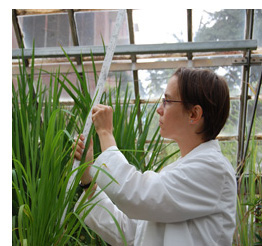
Meet the OK EPSCoR Researcher-of-the-Week: Dr. Laura Bartley
EPSCoR Bioenergy Project YouTube Video: Dr. Laura Bartley
Using Plants to Help Solve Energy Needs of the Future
 Dr. Laura Bartley, assistant professor of botany and microbiology at the University of Oklahoma, is an EPSCoR biofuels researcher who seeks to increase the efficiency of switchgrass as an alternative energy source through her expertise in the area of microbial conversion.
Dr. Laura Bartley, assistant professor of botany and microbiology at the University of Oklahoma, is an EPSCoR biofuels researcher who seeks to increase the efficiency of switchgrass as an alternative energy source through her expertise in the area of microbial conversion.
Dr. Bartley's research focuses on understanding grass phenylpropanoid synthesis and regulation for improved biomass production, as well as disection of grass wall-to-wall adhesion.
Phenylpropanoids in the form of lignin and the grass-specific ferulic acid (FA) in arabinoxylan constitute the major barrier to accessing cell wall polysaccharide and also a significant source of chemical energy. These compounds also have a role in plant disease resistance and stress tolerance, and human and animal nutrition.
Though grasses are the most abundant source of biomass in the US, we do not understand which members of the grass-expanded and -diverged families of the enzymes and regulatory proteins direct the wall incorporation of phenylpropanoids.
Dr. Bartley has found that rice plants that overexpress members of a grass diverged family of acyltransferases have reduced wall FA, improved deconstructability and normal growth. Transcriptional network analysis implicatesspecific members of phenylpropanoid biosynthesis in incorporation of FA into grass cell walls. In her biofuels research, she will be dissecting the grass FA incorporation and lignin biosynthesis pathways in rice, Brachypodium, and switchgrass through molecular genetic and genomic methods, detailed phenotypic and biophysical analysis of resulting mutants, and biochemical analysis of implicated enzymes.
Cell wall structure heavily influences the use of lignocellulosic material for biofuel production via fermentation and thermochemical methods. Each plant cell synthesizes its own wall, but the connections between walls are fundamental to formation of an intact plant body. Conversely, selective cell-separation is a common feature of plant development, including pollen, seed, and leaf dehiscence. Many cells are digested within bovine rumens from the cell-lumen side, suggesting that the connections between cells are crucial regions of recalcitrance within the cell wall matrix. The proteins and pectins that have been implicated in wall-wall adhesion from dicot genetic studies are inabundant in grass cell walls.
Dr. Bartley will be probing the roles of components and other genes that control and regulate wall-wall adhesion grasses, using similar approaches to those outlined above.
For more information, visit the researcher's EPSCoR page at http://www.okepscor.org/dr-laura-bartley.
